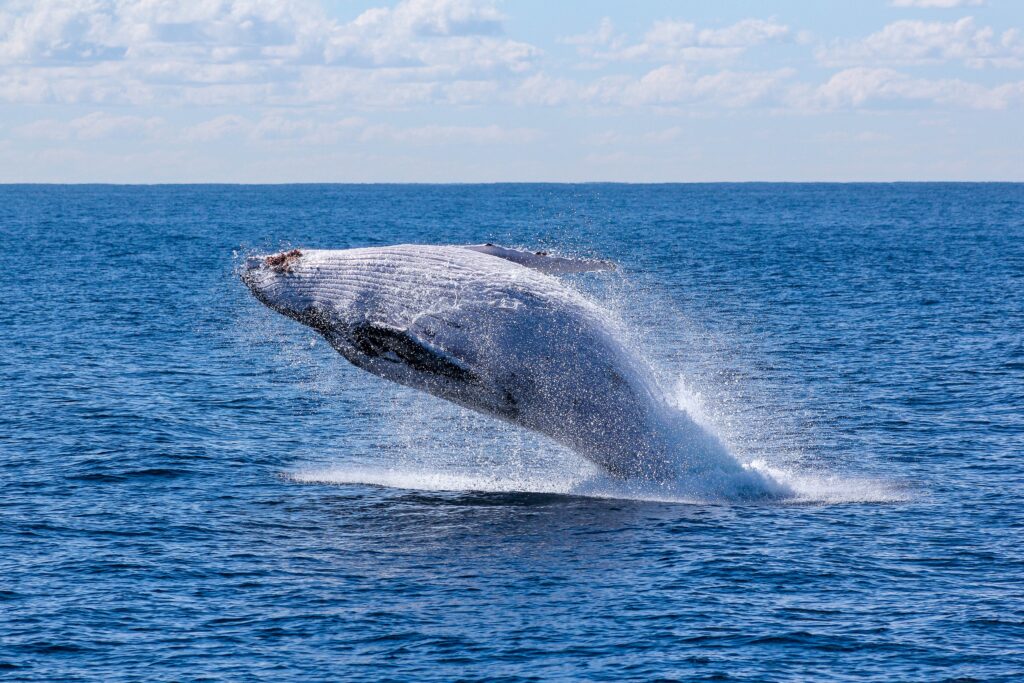
Rescuers free humpback whale found tied to 300lb crab pot in Alaska
A team of trained responders has successfully freed a juvenile humpback whale in coastal waters off Alaska, which was found entangled in a 300lb crab pot.
NOAA Fisheries received reports of a severely entangled whale in coastal waters near Gustavus, Alaska. A quick response by a dedicated team of trained responders — involving planes, drones, vessel- and shore-based efforts — helped free the stricken mammal.
“The Glacier Bay National Park entanglement response team was critical in this effort,” says Sadie Wright, large whale entanglement response coordinator at NOAA Fisheries‘ Alaska regional office. “They provided the vessel and staff to successfully evaluate the whale’s condition and then deployed a team to disentangle the whale.”
To help with assessment and strategy, the response team used a drone to collect aerial photographs and video of the whale.
NOAA Fisheries and the National Park Service team up to successfully rescue an entangled humpback whale near Gustavus, #Alaska : https://t.co/J0MM9F0ynh@GlacierBayNPS pic.twitter.com/13YIpDX2NU
— NOAA Fisheries AK (@NOAAFisheriesAK) October 26, 2023
Janet Neilson and Chris Gabriele with the National Park Service’s large whale entanglement response team coordinated shoreline and vessel-based assessments shortly after the first reports of the entanglement.
“Glacier Bay National Park Service personnel located the whale from shore and confirmed it was dragging two buoys. They were able to get out on the water right away to confirm the entanglement and take photos of the animal and gear that helped paint a much more thorough picture,” says Neilson.
Based on the assessment, the team determined that the entanglement was life-threatening. The whale appeared to be semi-anchored in place by line and buoys associated with a crab pot.
“We spoke with the gear owner, who was really helpful in providing details that allowed us to better understand the type and configuration of the gear entangling the whale,” adds Wright. “The gear included a heavy gauge line and buoys attached to a 300-pound crab pot.”
Fred Sharpe, advanced large whale entanglement responder with Alaska Whale Foundation, adds: “This was a complicated entanglement with a line through the whale’s mouth, and wrapped around the animal’s tail stock,” . “The drone imagery assisted tremendously with our understanding of the entanglement and how to prioritise our cutting attempts.”

A humpback whale breaches
Support teams with NOAA in Juneau, and NOAA whale disentanglement expert Ed Lyman at the Hawaiian Islands Humpback Whale National Marine Sanctuary on Maui assessed the drone imagery. They provided recommendations by cell phone as the team worked with the whale.
The seas were calm, aiding the responders’ efforts to help the whale. Using specialised tools to remove the line and buoys, the team patiently and deliberately made several cuts using specialised tools designed to keep responders at a safe distance from the whale.
This includes a knife on the end of a 25-foot carbon fibre pole and grappling hooks modified with razor-sharp knife blades inside the grapple to cut as they grab. They were able to remove nearly all of the line and the buoys.
Near the end of the day, the strategic approach paid off — the whale became more mobile with each cut of the rope until the gear finally loosened.
“The turning point came when we were able to cut the rope that ran through the whale’s mouth and was wrapped around its tail,” says Gabriele.
The whale could swim away, leaving the buoys and most of the line floating at the surface. While all of the floating portions of the line were collected, the pot hasn’t been recovered yet. It is likely sitting on the seafloor where the whale was last seen.
“Glacier Bay National Park staff plan to look for this animal in the coming weeks and document its condition if it is still in the area, and NOAA Fisheries staff will continue to seek resights to hopefully confirm the animal is in good condition and back to normal feeding and migration,” adds Wright.
In separate news, MIN reported yesterday (30 October 2023) that the National Oceanic and Atmospheric Administration (NOAA) has denied a petition to establish a mandatory speed limit and other vessel-related mitigation measures to protect the endangered Rice’s whale in the Gulf of Mexico.
According to NOAA, the decision — which was confirmed on Friday (27 October 2023) — was made based on various factors, including scientific assessments, the potential economic impact on commercial and recreational activities, and the effectiveness of existing conservation measures in the region.
The post Rescuers free humpback whale found tied to 300lb crab pot in Alaska appeared first on Marine Industry News.
